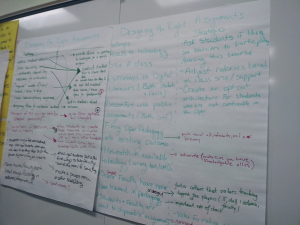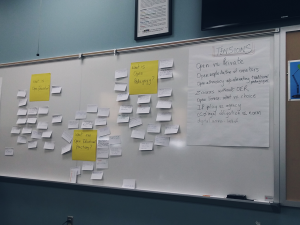Traditional learning materials such as textbooks can limit access to innovative teaching and learning practices. With Open Educational Resources (OERs), teachers and students are freed from the constraints of these materials and are empowered to adapt, use, and share learning materials created by others. This is a series of two blogs that will explore the importance of OERs and the resources needed for creating our own open resources for language learning?.
First, let’s take a brief look at what makes OERs appealing, yet challenging to adapt and create in language education.
A Brief Overview
Open Educational Resources (OERs) are a key component of an approach to learning known as Open Pedagogy, which aims to leverage the use of shared resources to improve educational outcomes. Simply put, OERs include “any educational resources (including curriculum maps, course materials, textbooks, streaming videos, multimedia applications, podcasts, and any other materials that have been designed for use in teaching and learning) that are openly available for use by educators and students, without an accompanying need to pay royalties or license fees” (Butcher, 2015, p.5). OERs are usually shared under a Creative Commons license which allows users to revise, remix, retain, reuse and redistribute these materials without incurring any copyright infringement (The 5R activities).
“Going open is more a philosophy than a skill. But, obviously, it takes a handful of skills to be able to apply this philosophy in the classroom”
Małgorzata Kurek Anna Skowron
Language instructors and researchers have recognized the potentials that OERs bring to the language classroom. We call these potentials the ecology of OERs for the language classroom—the complex connections and relations that exist in the process of teaching and learning another language and its cultural foundations. In this ecology, we find benefits including adapting authentic materials, merging literacy and culture, and fostering multiliteracies (e.g., digital, information). Yet instructors and researchers also acknowledge the barriers to widely adopting open resources.
Opportunities
OERs can engender creative and innovative practices for making language teaching and learning more meaningful, enjoyable, authentic, and democratic. Open resources can be game-changers that reshape the classroom ecology and its dynamics—fostering a hub for new social learning. These resources can challenge the social norms and behaviors expected in the language classroom, making instructors and students collaborators. Both students and instructors can become active producers of content, transforming the language class into more democratic and participatory. A participatory approach to making students content creators can promote opportunities for students to be exposed to authentic uses of the language and, thus, increase their motivation to learn and use the language in more meaningful and relatable ways (Blyth & Thoms, 2021).
OERs create opportunities for adapting and repurposing content to fit particular contexts and uses, levels of skills, student characteristics, instructors’ competencies, and available technologies. Both students and instructors can engage in higher-order cognitive processes as they retain, revise, remix, reuse, redistribute, and evaluate copyrightable works. OERs often come in different formats such as videos, interactive content, gamified practices, animated presentations, audio effects, etc. making the content and learning experience more engaging as well as connected to students’ language learning interests and needs. In addition, OERs are easily adapted, foster language and literacy skills for students, and are beneficial for the professional development of instructors. OERs can promote the development of digital multiliteracies for instructors (Mitsikopoulou, 2019), who could eventually integrate multiliteracies into their teaching practices organically.
Commercial textbooks can become outdated quickly, and updating them can take a long time. In addition, instructors might find more challenges adapting or reusing these textbooks due to copyright laws. The open nature of OERs offers instructors the opportunity to adapt multiple resources to innovate their teaching practices and expose students to more realistic content that is current and relevant. Even further, using OERs in the language classroom may contribute to going beyond the goal of language education—from a communicative perspective where learners are expected to develop the language skills to communicate with other speakers of the target language to a learning experience that fosters literacy (Thoms & Thoms, 2014).
In broadening language teaching goals, instructors can become content-generators and create their own OERs. Instructor-generated OERs afford the opportunity for instructors to rethink their pedagogical content and practices in a way that can broaden their understanding and perspectives of the world. Instructors can integrate more content from the language and culture of diverse communities around the globe, decentering the language usage of a particular dominant group within the community of speakers. For instance, many Spanish textbooks in the U.S. focus on the Spanish language and culture from Spain, failing to embrace the multifaceted nature, complexity, and nuances of the language and culture in the other 20 Spanish-speaking countries in the world.
Challenges
While interest in and implementation of OERs has grown across disciplines since the early days of the open education movement, adoption of these resources among foreign language educators has been slower and continues to present a number of challenges that may limit the efforts to integrate them into some educational contexts. Persisting barriers may include reluctance to reuse material created by others and share resources more broadly (Rolfe, 2012; Weller, 2011); lack of guidelines on the use and evaluation of OERs for quality and accuracy of the content (Adams et al., 2013); technical difficulties in access, development, and delivery of content; need for a sustainable team for development and authoring; and compliance with accessibility standards (Baker, 2012). It is notable that many of the challenges identified here represent a historical perspective of the OER movement. However, these potential obstacles, along with “a lack of research which investigates the benefits and challenges of FL learning and teaching in open environments” (Blyth and Thoms, 2021), continue to hinder the widespread use and creation of open resources among foreign language educators.
Supporting Efforts to Incorporate OERs in the Language Teaching and Learning

The benefits of OERs across disciplines has been by now well-documented. Language programs and educators weighing the barriers to creating OERs should not be discouraged. To the contrary, it is critical to support efforts to democratize education through the use of OERs and open education initiatives. These efforts include: (1) providing research-based and empirical evidence of the benefits and impact on language education, (2) grounding the development of OERs on theoretical and practical frameworks to ensure quality of learning experiences, (3) training users and developers of OERs on how to find, adopt, adapt, evaluate and create open resources, (4) supporting the use of technologies and Creative Commons licensing for OERs, and (5) creating clear guidelines for instructional practices (Zapata & Ribota, 2021). An important piece in adopting OERs and advocating for the open pedagogy movement is to support instructors who want to venture into creating their own OERs. How do we get started with our own OER project? What considerations are critical for this kind of project? What resources are needed and available? Who will be involved and how will their different areas of expertise be integrated? We believe it is necessary to discuss these questions (and possibly others). In Part 2 of this series, we outline a detailed process and structure for language programs to determine the appropriate scope and sequence within the larger curriculum, author rich thematic content, weave cultural and social justice topics into language skills content, promote multiliteracies, and produce media objects or search for existing media and images in the public domain.
References
Adams, A., Liyanagunawardena, T., Rassool, N., & Williams, S. (2013). Use of open educational resources in higher education. British Journal of Educational Technology, 44, 149– 150. doi:https://doi.org/10.1111/bjet.12014
Baker, J. (2012). Introduction to open educational resources. Connexions. http://cnx.org/content/col10413/1.3
Blyth, C. S., & Thoms, J. J. (Eds.). (2021). Open education and second language learning and teaching: The rise of a new knowledge ecology. Multilingual Matters. https://www.multilingual-matters.com/page/detail/?k=9781800411005
Butcher, N. (2015). A basic guide to open educational resources (OER). Commonwealth of Learning (COL).
Wiley, D. (n.d.). Defining the “Open” in Open Content and Open Educational Resources. Creative Commons Attribution 4.0 license
Lesko, I. (2013). The use and production of OER and OCW in teaching in South African higher education institutions. Open Praxis, 5(2), 103-121. https://www.openpraxis.org/articles/abstract/10.5944/openpraxis.5.2.52/
Mitsikopoulou, B. (2019). Multimodal and digital literacies in the English classroom: Interactive textbooks open educational resources and a social platform. In N. Vasta., & A. Baldry. (Eds.). Multiliteracy Advances and Multimodal Challenges in ELT Environments, (pp. 98-110). Udine.
Rolfe, V. (2012). Open educational resources: Staff attitudes and awareness. Research in Learning Technology, 20, 1–13.https://doi.org/10.3402/rlt.v20i0.14395
Thoms, J. J., & Thoms, B. L. (2014). Open educational resources in the United States: Insights from university foreign language directors. Systems. http://www.tesl-ej.org/wordpress/issues/volume22/ej86/ej86a2/
Weller, M., De los Arcos, B., Farrow, R., Pitt, B., & McAndrew, P. (2015). The impact of OER on teaching and learning practice. Open Praxis, 7(4), 351-361.
Zapata, G., & Ribota. (2021). Open educational resources in heritage and L2 Spanish classrooms: Design, development and implementation. Open Education and Second, 25.



